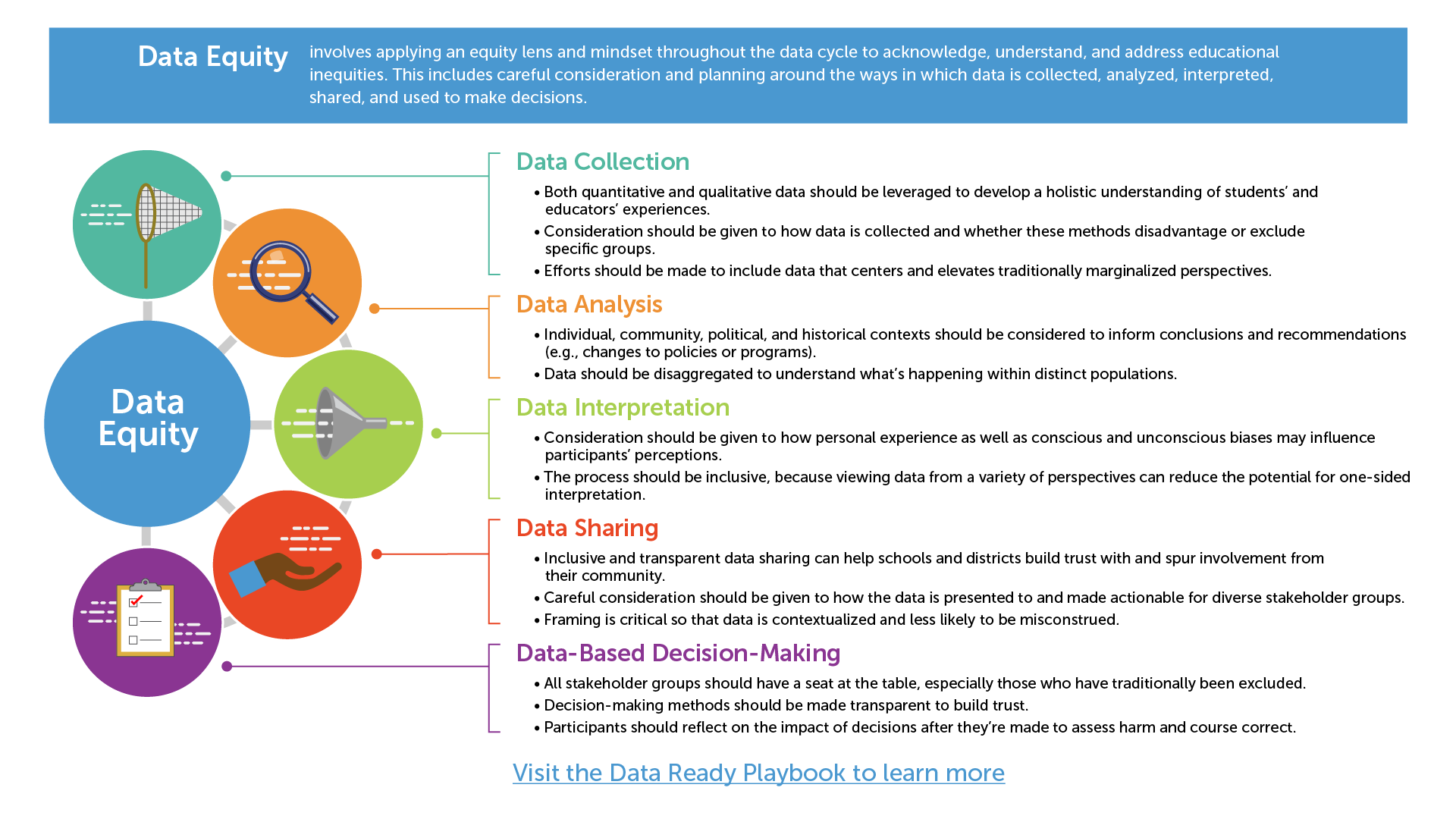Understanding Data Equity
Achieving Data Equity through Inclusive Innovation
We often speak of the achievement gap in public education. In fact, there are many different types of gaps in schools and school systems that contribute to inequitable treatment and outcomes for students. As the COVID-19 pandemic has highlighted, there are significant gaps in access to technology. There are also often gaps in students’ and families’ sense of belonging, ability to navigate the school system, and access to academic and extracurricular programming as well as culturally responsive social-emotional support. Additionally, gaps often exist in educators’ and staff members’ expectations of student performance and achievement.

Data equity begins with school stakeholders (e.g., school leaders, educators, staff, and students) and community stakeholders (e.g., families, respected elders, representatives of local community-based organizations, churches, colleges/universities, and businesses) building relationships, trust, and a shared commitment to working together to co-design more equitable approaches to working with data. Co-design teams should acknowledge power dynamics and bias and consider how to center and amplify the voices, perspectives, and expertise of historically marginalized populations—Black, Brown, and Indigenous students; students with learning differences; students experiencing poverty; and/or English learners. They should understand the cultural impact and ripple effects that data have on historically marginalized students and families and be open to models of student success and engagement that consider whole-child, culture, and identity factors. Additionally, they should be willing to face difficult truths about existing inequities and be committed to implementing an equity agenda, from leadership to the classroom level.
For more information, the article below lists foundational capacities needed to support data driven decision making. As you read the article, think about which conditions apply to your current situation. https://www.gettingsmart.com/2023/02/09/school-systems-lack-capacity-to-support-data-driven-decision-making-national-survey-finds/

In the video below learn how data equity and data interoperability are connected, see actual examples of districts who have successfully applied a data equity lens and used resources from the Data Ready Playbook to create their challenge and solution statement and achieve district goals around equity and inclusion.

Conduct a data equity audit by utilizing the “Data Equity Audit Tool” found in your Module 1 resource file. Submit your completed audit as evidence for fulfilling part of the Data Equity and Data Interoperability Foundation Micro-credential
Integrating Equity in the Data Lifecycle
- The Data Review Committee
- Data Collection
- Data Analysis
- Data Interpretation
- Data Sharing
- Data-Based Decision-Making
Data equity work begins with the creation of a core team called the Data Review Committee, which is comprised of school leaders, educators, and community partners, including students and families. This core group will serve as the leadership team for this work and be charged with ensuring that equity, diversity, inclusion, belonging, and cultural responsiveness are centered and prioritized. The composition of the core team should be reflective of the overall student population. The team should meet at least once per month; ideally, they will meet bi-weekly. (Note: Some members of the Data Review Committee will also serve on the Data Governance Committee referenced in Project Governance: Committee Model, Roles, and Responsibilities in Module 2.)
What interoperability standards are used to ensure the strategies will be able to validate results and share data across appropriate systems?
Schools and community partners should work jointly to critically examine existing data sources and data collection processes. Data equity requires both qualitative and quantitative data. Students’ and families’ stories can’t simply be told through numbers and performance measures; they must also be understood through their own narratives and lived experiences.
When gathering data, schools and community partners should ask why the school is collecting the data, what types of data are being gathered and valued, who the work will benefit, and how the process and product might cause harm to specific members of the community. They should consider sample selection, research design, collector behavior, scope and scale, cultural translation, and collection mediums among other factors. Through this process, schools and community partners can identify which data match the purpose for which they are intended, which do not, and where gaps exist in data collection.
Once they’ve collected data, schools and their community partners need to make important decisions about how the data will be analyzed and the implications for equity. The statistical methodology that schools use, the variables they choose to include or exclude from their models, and the way they choose to classify each data point impact the results.
Data disaggregation is critical to fully understanding what’s happening within distinct communities. However, it is important not to disaggregate data in such a way that intersectionality is overlooked. Applying an equity lens during data analysis involves incorporating individual, community, political, and historical contexts to inform analysis, conclusions, and recommendations.
How we interpret the results of data analysis is heavily influenced by our experiences, our opinions, and our biases, many of which may be implicit. False assumptions about causality, correlation, expectations, and relevant factors can lead to flawed conclusions. For example, when looking at data indicating higher rates of disciplinary sanctions against students of color, it would be a mistake to automatically assume that students of color have a higher incidence of disruptive behavior. Instead, a careful analysis should include consideration of enforcement data to determine whether there are discrepancies.
Data equity requires schools and community partners to consider who will be involved in data interpretation and how viewing data from a variety of perspectives can reduce the potential for one-sided interpretation. Being transparent about what data is used to inform data interpretation and clearly documenting the process can help to build community members’ trust, capacity, and consensus.
Data equity also involves careful attention to how data interpretation is communicated and to whom. Schools can build trust with their communities by being transparent and inclusive in sharing data. Sharing and communicating about data is an important mechanism in telling the story of a school—what is valued and how education will be conducted—so sharing should be closely tied to the previously established purposes of data and data collection.
The team must be conscious of the language, framing, and presentation style they use and work with community partners to consider how different approaches can make the data accessible to a wide variety of audiences and stakeholders. Framing is critical, because findings that may appear neutral can be easily misconstrued. For example, sharing that a school district’s standardized test scores have decreased without providing context, such as the fact that the district switched to a new testing provider or curriculum, could fuel a narrative around failing schools and diminish the community’s confidence.
Finally, data equity involves consideration of who is involved when decisions are being made based on data. Schools and community partners should ensure that representatives of all stakeholder groups have a place at the table, especially those who have traditionally been underrepresented. They should ask how they can make the process inclusive and transparent to build trust and shift power dynamics that privilege some members of the community while disadvantaging others.

Additional resources can also be found in your Module 1 resource file, such as Project Unicorn’s Standards Glossary: An A-Z Glossary of K-12 Interoperability Standards and an article from Edweek titled “Street Data: A New Grammar for Educational Equity.”
Sources
- A Toolkit for Centering Racial Equity Throughout Data Integration. Actionable Intelligence for Social Policy (AISP), University of Pennsylvania.
- Data Equity Framework. We All Count.
- A Whole Child Approach to Equity and Achievement. Mackey Pendergrast, Superintendent of Schools, Morris School District.
- Principles for Advancing Equitable Data Practice. Marcus Gaddy and Kassie Scott. Urban Institute. June 2020.